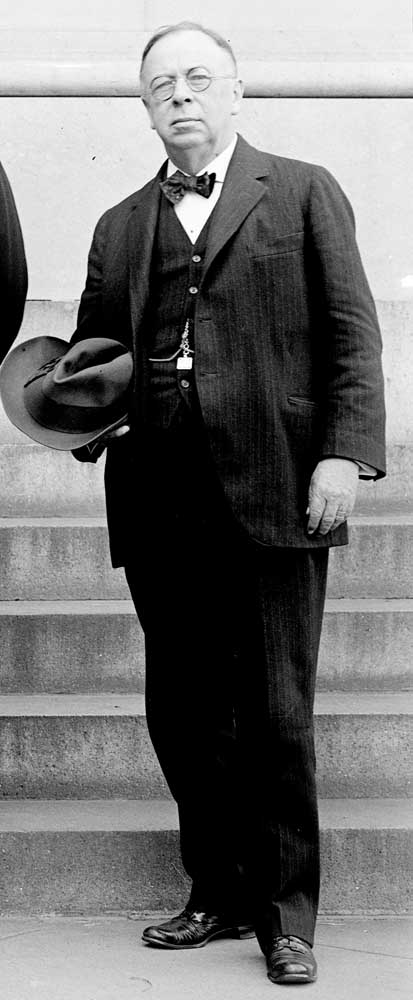Offbeat Oregon: Shelton steps in to governor’s hsoes
Published 2:00 am Tuesday, April 18, 2023

- Senator George Earl Chamberlain
Editor’s note: This is the second in a series. Visit redmondspokesman.com to read the story in its entirety.
Trending
George Chamberlain served six years — one and a half terms — as Oregon governor with Caralyn Shelton by his side. His wife, Sallie Welch Chamberlain, had no desire to leave her social and family connections up in Portland and was more than busy with their seven children, so the Chamberlains maintained their home up in the big town for the family and George “batched it” in the governor’s mansion, traveling home as frequently as he could. Caralyn basically took over the social-secretarial functions of a First Lady so that Sallie could focus on her family up north.
In his book, historian Richard Roth says she and Chamberlain likely had an long-running affair during this time. That may be so, but I’ve found nothing in my research that supports or even suggests this, and Salem has never been a town that can keep a secret, especially one involving both sex and partisan politics, for anywhere near that long.
Halfway through his second term in office, Chamberlain ran for a seat in the U.S. Senate and won the election. So he resigned his office as governor in favor of his Secretary of State, Frank W. Benson, and prepared to board an eastbound train to take his new seat.
Trending
There was a problem, though.
The entire freshman crop of senators from all across the country — every new senator who had won the 1908 election — was slated to be sworn in and seated on March 4, 1909. As seniority was determined by the date of swearing-in, all those senators, including Chamberlain, would have equal seniority to one another, unless one of them arrived in D.C. late and missed the swearing-in. If that happened, the latecomer would be junior to all the other members of his incoming class.
And that was a problem because March 1 was the day Benson was scheduled to be sworn in as Oregon governor.
If Chamberlain stayed in Oregon through the end of his term, he wouldn’t arrive in D.C. until three or four days later, and he’d miss the swearing-in ceremony. That would mean that every other member of the incoming 1908 freshman class of senators would have seniority over him.
No problem. This had happened before, and the solution was an easy one. The incoming governor simply came in a few days early with the title of acting governor. Then, when March 1 came along, he’d be sworn in for real.
But there was a problem this time. On Feb. 27 when Chamberlain boarded that eastbound train, Secretary Benson, who was already struggling with the recurring illness (possibly malaria) that would kill him three years later, was too sick to play his part.
This wasn’t uncharted territory either. There was a contingency plan in place. If the Secretary of State couldn’t step in as acting governor for any reason, the job fell to — you guessed it — the governor’s private secretary.
And thus it was that, on Feb. 27, the state of Oregon became the first in U.S. history to have a woman governor.
Governor Shelton
March 1, 1909, was a Monday, and by 10 o’clock Benson was feeling well enough to take the oath of office and step into his new role. This brought Caralyn Shelton’s 49-hour political career to a triumphal end.
By the way, the newspapers in 1909 found this whole exchange highly amusing and covered the situation extensively. Governor Shelton made a point of telling them she would veto no bills, promulgate no executive orders, and grant no pardons during her term. As far as I’ve been able to learn, nothing much happened during her time in office. But if anything had, she would have been the state’s chief executive in charge of dealing with it. And it’s clear that everyone involved had total confidence in her ability to do so, if she had to.
And after Benson took over, Caralyn boarded a train to D.C. to take her place in Chamberlain’s office.
She served there in Chamberlain’s office in D.C. throughout his two terms as a senator. When he was defeated for re-election in the 1920 “red wave” of anti-Woodrow Wilson votes, settled down in D.C. in private practice. And in July 1926, a suitable interval of time after Sallie Chamberlain’s death at age 70 … reader, she married him.
This was, of course, another “first” — the first case of two former state governors marrying each other in U.S. history. By this time, Chamberlain was 72 years old, and Caralyn a youthful 50. They had been friends and business partners for most of their lives.
Married life
George and Caralyn Chamberlain only got to live together as husband and wife for a few months. Shortly after (or possibly before; the records aren’t clear) the marriage, George suffered a paralytic stroke. He lingered on for some months after that, an invalid, being cared for by Caralyn. In 1928, three days before their second wedding anniversary, he died.
Caralyn followed ten years later, on Feb. 2, 1936, at the age of 59. Oddly, none of the many obituaries that ran in newspapers around the state even mention her 49-hour term as governor.
A quick footnote: There is much confusion about Caralyn Shelton’s name. Newspaper articles about her, of which there were many, called her “Carolyn.” Her great-great niece, Anne Mitchell, told Bryan Vance of OPB that her birth name was Carrie, but that she changed it to Caralyn to sound more formal in her role as George Chamberlain’s top paralegal. In any case, the name used in her obituary and carved on her gravestone is “Caralyn,” so that’s what I have adopted for this story.
U.S. History
— First woman state governor
— First ex-governor to marry another ex-governor (tie with George Chamberlain)
Oregon history
— First woman Governor’s Private Secretary
— First woman governor
— Youngest governor (32)
— Shortest-serving governor (49 hours)
The Central Railroad of Oregon, a book by Richard R. Roth published in 2015 by Heritage Quest Press
“The Governor who Couldn’t Vote: Why History Forgot Oregon’s First Female Head of State,” an article and news report published Feb. 27, 2019, by Oregon Public Broadcasting
“Heritage: Oregon’s first woman governor lasted a weekend,” an article by Kaylyn F. Mabey published on Feb. 12, 2015 in the Salem Statesman Journal
A series of articles written by Dr. Kimberly Jensen and posted in April and May 2014 on Kimberly Jensen’s blog.








